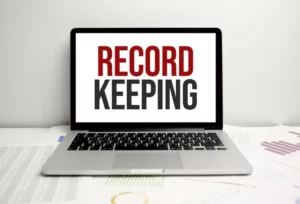As an owner of a painting business, you know that creativity, commitment and meticulousness go hand in hand. This applies not only to art projects — it’s also vital to ensure diligent bookkeeping. Nevertheless, even the most devoted entrepreneur may face difficulties when it comes to managing financial records. You need to document financial transactions, monitor expenditures, and handle invoicing — it’s easy to get overwhelmed. Today, we’ll shed light on the intricacies of efficient bookkeeping for painters and give you some ideas on how to strengthen your financial foundation.
Setting Up Your Painting Business to Get Financial Success
Bookkeeping for painters entails documenting and structuring financial activities. It encompasses maintaining a detailed log of all financial inflows and outflows within your painting company. But why is it relevant to painters and decorators? Accurate bookkeeping will benefit you with the following tasks:
- Assessing the financial health of the business.
- Simplifying the process of tax control.
- Making well-informed financial solutions.
- Presenting a transparent overview of gains and losses.
However, you don’t have to control the full range of finance-related issues on your own. There are professional bookkeeping service experts like BooksTime who make your life less stressful in many ways:
- Save time;
- Better financial decisions;
- Enhance cash flow management;
- Help with tax obligations;
- Reduce errors & fraud.
In addition, today, you can find numerous accounting software simplifying the tasks of painters. It is possible to control earnings, expenses, and invoices in one app. Some of them go a step further — they create reports which simplify the submission of tax returns. Choose options meeting your unique requirements. If finances are not your forte, give preference to convenient options. They should have easy-to-use navigation and informative guides. Also, look at cloud accounting solutions. It lets you access your documentation from any device and from any location.
Managing Cash Flow for Your Painting Business
Cash flow is the heartbeat of any enterprise. Effective financial management is pivotal to the financial well-being and longevity of the firm. So, how do you keep that heartbeat going? Here are several instructions:
- Build a cash flow plan forecasting your anticipated earnings and expenditures throughout the coming months. The projection furnishes a clear overview of the cash flow patterns and aids in predicting times of overflow or deficit.
- Establish an emergency reserve to tackle unforeseen expenses or phases of reduced income. Even when you face unexpected hurdles, this financial buffer assures your firm remains resilient.
- Expedite the invoicing process to be sure your invoices are transparent and correct. Properly define payment terms and deadlines. As a nice alternative, consider incentives for early settlements to motivate clientele to clear their invoices.
- Every entrepreneur must closely monitor the accounts receivable; they denote the funds owed to them by customers. Control overdue payments and initiate a collection procedure if required.
Billing for art commissions, gallery sales, and painting services is another vital aspect of cash flow management. To streamline the procedure, adopt certain approaches that ensure prompt payments. First, use written agreements highlighting the scope, pricing, and payment schedule. They offer clarity and assurance to both parties. Moreover, request advance payments, typically 20% to 50%. They help to mitigate financial risks.
Essential Bookkeeping Practices
Accounting is not something that every artist dreams of every day, but if you want a profitable business, keep your books in order. You will always know how much paint you have, who paid you and who didn’t, and whether you profit from exhibitions. This all adds up to how successful your business is. Let’s take a look at the best practices of bookkeeping.
Track daily inventory
No one becomes an artist to immerse themselves in monotonous organizational work. However, if you are a professional artist, you must keep track of your inventory daily. You can take time each morning to assess and record your inventory levels. Paints, brushes, drywall, and other materials — write down everything necessary. In specialized accounting or inventory management software, you can track this data. Check your inventory at the end of each day. Check the items you’ve used compared to your original stock level to see what needs replenishing.
Prepare profit and loss statements
Any successful business owner must also assess the financial state of the firm. What is the optimal way to do this? Most entrepreneurs choose to create income statements. They consolidate the costs, expenses, and income accumulated by your painting business over a specific time frame. In addition, you can estimate how profitable your firm is and how long it can remain so.
Keep up with taxes
It’s essential to control taxes to prevent any issues with the IRS. You have to monitor the sales tax you collect, keeping in mind that sales tax rates and rules vary by state. As a freelancer, you have to pay self-employment tax, which includes Social Security and Medicare contributions. You’ll calculate and report this on Schedule SE, which is filed along with your regular income tax return (Form 1040). Keep track of deadlines, including quarterly payments, and file your annual return promptly to steer clear of penalties.
Regular reconciliation
Regularly check all your records to ensure their accuracy. To stay at the top of your game, compare the disclosed income and expenses against bank statements and other documents. It’ll help spot any inconsistencies or mistakes that need to be corrected.
Enhancing Profitability Through Financial Insights
Financial reports reveal valuable insights. After all, they guide your strategic growth. You can pinpoint the most lucrative revenue streams by examining sales patterns across exhibitions, gallery placements, and commissioned works. This empowers you to prioritize high-performing channels. As an example, if gallery placements consistently outshine other options, you may prioritize securing additional placements.
Budgeting to grow
If you want effective budgeting to help grow your art business, keep a few things in mind. First, your initial step to growth can be a flexible budgeting strategy. When the situation changes — you can easily change your plans.
Moreover, you should identify tactics for saving money. In order not to waste money on unnecessary things, allocate funds based on clearly defined goals. Note that you must also have marketing resources. After all, if you want to increase the popularity of the brand, you need to enter new markets. The secret is simple — constantly evaluate and reevaluate your budget. Financial conditions change as rapidly as trends in art.
Strategic pricing
The ideal pricing strategy should accurately reflect the cost of the artist’s work, the material costs, the time invested and the unique value of the art. Here’s how to approach it:
- Calculate all expenses incurred in creating the artwork — material costs, studio rent, and utilities. Take into consideration the time spent creating the piece.
- Research the market to understand the pricing range of similar artworks.
- Evaluate what sets your artwork apart from others in the market. Consider various factors: your artistic style, technique, concept, and the emotional or intellectual impact of the piece on viewers.
Your cost calculations, market research, and unique value assessment will help establish your pricing structure. Moreover, try offering different price levels or options tailored to different types of buyers or collectors.
Conclusion
Perhaps you think that bookkeeping for painters is not as exciting or important as creating incredible paintings. However, don’t let this misconception confuse you — your financial management is the heart of the business. Being an artist is one half of the story, but keeping proper books is another. As an art business owner, you’re in charge of making the company successful.
Still, BooksTime is always ready to assist you with these tasks. Our specialists understand all the nuances of the painting business, so whether you need expense tracking or payroll management, we can help. Contact our experts to get all-encompassing help in bookkeeping for painting contractors. You may leave worries about the financial state behind, and concentrate on creativity and business development.


















